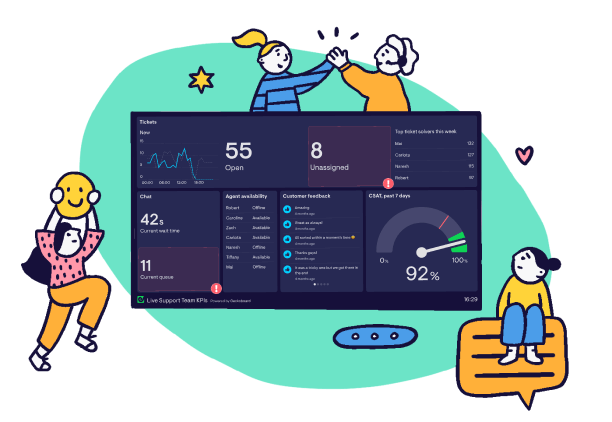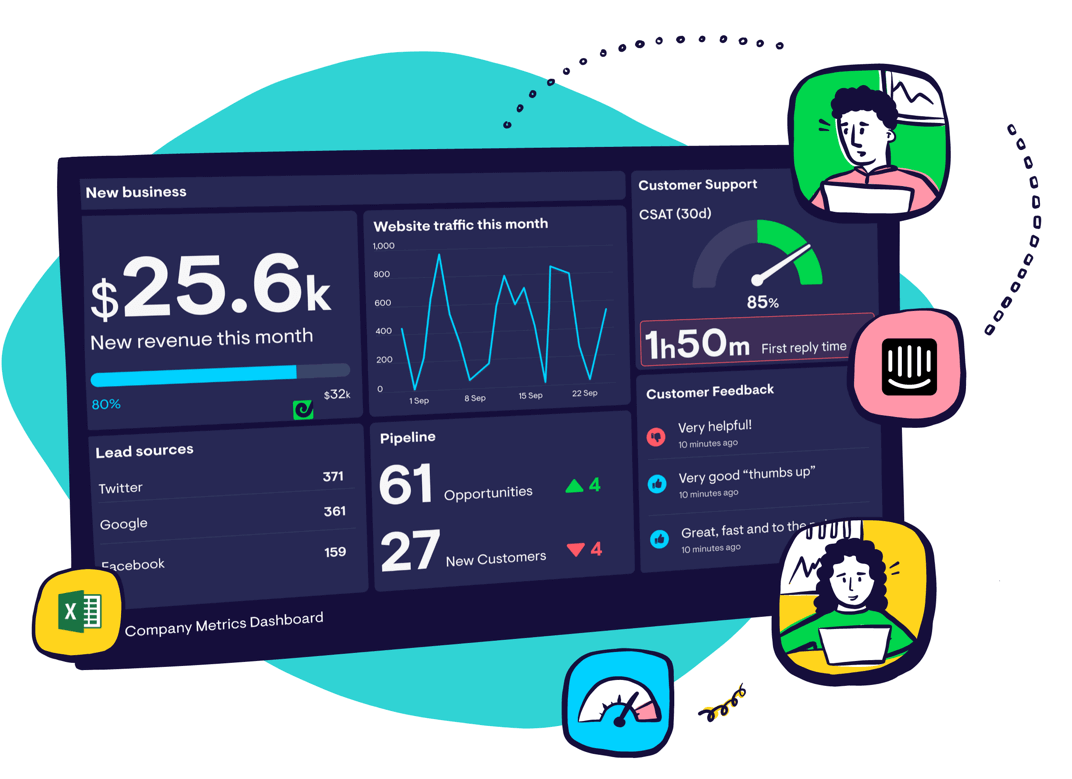First Contact Resolution Rate (FCR)
First Contact Resolution rate is a metric that’s useful for you when tracking and improving customer service efficiency as well as customer experience. However, it’s a metric that has some potential pitfalls and shouldn’t be used on its own.
What is First Contact Resolution rate?
First Contact Resolution rate, also known as FCR, is a metric that measures the percentage of customers’ questions and requests solved at first contact.
You know that an issue is solved at the first contact when the answer is ‘yes’ to the two questions below:
- Is this the first time the customer has reached out with this request or question?
- Is the issue at hand fixed?
How you define fixed is very important. In Zendesk and similar tools it usually depends on the customer support representative flagging the ticket as solved. If the customer gets back in touch regarding the same issue within a certain period of time the issue is reopened.
How to calculate First Contact Resolution rate
Get your First Contact Resolution rate with this calculation:
(#) issues resolved on first contact / (#) total no issues X 100 = First contact resolution rate (%)
Let’s say that over a month, your customer service team has dealt with 175 questions and requests from your customers. Out of that, 112 of these issues were resolved at first contact.
The calculations for your First Contact Resolution rate would therefore look like this:
(112 / 175) x 100 = 64%
Why you should keep an eye on FCR
First Contact Resolution rate can be a useful way to track efficiency, how well your CS team responds to enquiries, and can be a good indicator of customer satisfaction.
Customers, who spend less time and put in less effort in solving issues with the product or service they’re buying, are happier. And as the Harvard Business Review explains, this is key to customer satisfaction:
“First, delighting customers doesn’t build loyalty; reducing their effort – the work they must do to get their problem solved – does. Second, acting deliberately on this insight can help improve customer service, reduce customer service costs, and decrease customer churn.”
The less effort for the customer the better.
First Contact Resolution rate vs. First Response Time
As FCR measures what proportion of tickets are solved on first touch, it doesn’t track how fast customer support is at giving an initial response to the customers. The First Response Time metric tracks just that.
A quick first reply minimises how long a customer has to wait for a response. FCR measures what proportion of first responses solve the customer’s problem.
Unlike First Response Time, FCR doesn’t encourage replying to the customer as soon as possible at any cost. The condition that a ticket must be resolved emphasizes the importance of quality replies that help resolve customers’ issues.
Ideally though you want both a high FCR and a low first response time.
Give your support team a boost
With Geckoboard’s real-time dashboards, everyone knows exactly what’s happening in CS right now.
Find out more
Problems with using First Contact Resolution Rate as a metric
There are also downsides to First Contact Resolution Rate that are important to keep in mind when using it.
Many think that a higher First Contact Resolution rate means that your company has a good and efficient customer service. But a high FCR may just mean you’re not doing enough to improve your documentation, build self service systems, or address bugs. Focusing too much on FCR can perversely disincentivize improvements because reducing simpler issues that can be solved quickly means the CS team are left with more complicated issues that can’t be solved on first touch.
The FCR metric can disincentivize teams to improve their self-service systems and documentation. This is because easier tickets to solve, that help keep FCR low, are reduced. The support team are left with harder tickets to resolve and FCR goes down - despite the user getting a better experience.
How quickly you respond to an inquiry is vital to ensuring customer satisfaction. Customers don’t want to wait too long before they get help. However, the First Contact Resolution Rate metric doesn’t take into account how long it takes customer support to send an initial reply to the customer. It’s no good spending days crafting the perfect one touch reply if your customer is left waiting.
Another drawback of FCR is that it’s very dependent on how you define an inquiry as being resolved. It’s important to consider this, as you don’t want to incentivise a team to mark tickets as solved when they in reality aren’t. You should also keep in mind that just because a customer doesn’t reply to an answer it doesn’t necessarily mean that the question or request has been solved.
Even though the First Contact Resolution Rate tracks efficiency and feeds into customer satisfaction, most CS teams choose to focus on CSAT.
FCR can be a useful metric, but it should always be paired with CSAT and First Response Time.your customer service.
What’s a good First Contact Resolution rate?
It’s always good to have a benchmark where you can compare yourself and your rates with others. This gives you an idea of where you are. However, finding a benchmark that is actually valid when it comes to First Contact Resolution is tricky.
Across industries many claim that the benchmark for FCR is around 65-75%. But that doesn’t mean that you have a good or bad First Contact Resolution rate if you are above or below 65 % and 75 % because First Contact Resolution rates vary widely from company to company. The rate depends on what kind of service or product you offer. Companies who offer technical products will most likely have a harder time resolving issues on first contact compared to, for instance, an ecommerce company.
There are also many other factors that can affect your First Contact Resolution rate as it all comes down to how your company handles tickets and which tools you have in place to work with it. Your firm might have an amazing self-service system so you don’t get easy calls as the customers can find their answers in other places. This setup would give you a lower First Contact Resolution rate.
On the other hand, another company might not have this self-service system. That means they would get more calls from customers who have easy requests and questions. In this case, the company would have a higher FCR rate than you. However, that doesn’t necessarily mean that they have better customer service.
In other words, you won’t find a universal standard for the good First Contact Resolution rate. Service Quality Measurement Group claim that every time your company increases its FCR rate with 1%, your customer satisfaction also increases with 1 % - but we’re skeptical.
The more effort a customer needs to put in to get an issue or question resolved the less likely they are to stay loyal to the company. How much effort customers feel they need to spend to get an issue resolved is something FCR doesn’t track. That however is what Customer Effort Score (CES) is designed to measure. CES is determined using a short survey that asks customers how easy they found it to interact with your company. Answers can help you increase your efficiency as well as your customer satisfaction.
Boost your dashboard with First Contact Resolution rate
Tracking First Contact Resolution rate on a live customer support dashboard keeps you focused on improving your customer service, not just improving your efficiency. You can use this rate to set up your own goals for how many issues should be fixed at first contact.
Add this KPI to your Geckoboard dashboard and you effectively monitor your First Contact Resolution rates across customer service channels.
If you’re adding First Contact Resolution rate to your dashboard, you might be interested in tracking some other Customer Support KPIs such as these:
